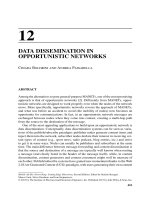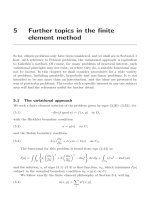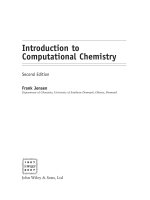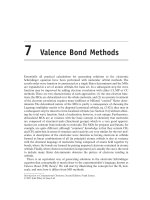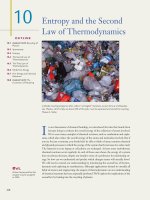Ebook Elseviers integrated review pharmacology (2nd edition) Part 1
Bạn đang xem bản rút gọn của tài liệu. Xem và tải ngay bản đầy đủ của tài liệu tại đây (6.84 MB, 141 trang )
ELSEVIER’S INTEGRATED REVIEW
PHARMACOLOGY
Intentionally left as blank
ELSEVIER’S INTEGRATED REVIEW
PHARMACOLOGY
SECOND EDITION
Mark Kester, PhD
G. Thomas Passananti Professor of Pharmacology
Director, Penn State Center for NanoMedicine and Materials
Co-Leader, Experimental Therapeutics, Penn State Hershey Cancer Institute
Kelly D. Karpa, PhD
Associate Professor
Department of Pharmacology
Penn State College of Medicine
Kent E. Vrana
Professor
Elliot S. Vesell Professor and Chair of Pharmacology
College of Medicine Distinguished Educator
Penn State College of Medicine
1600 John F. Kennedy Blvd. Ste 1800
Philadelphia, PA 19103-2899
ELSEVIER’S INTEGRATED REVIEW PHARMACOLOGY,
SECOND EDITION
ISBN: 978-0-323-07445-2
Copyright # 2012 by Saunders, an imprint of Elsevier Inc.
Copyright # 2007 by Mosby, Inc., an affiliate of Elsevier Inc.
No part of this publication may be reproduced or transmitted in any form or by any means, electronic or
mechanical, including photocopying, recording, or any information storage and retrieval system, without
permission in writing from the publisher. Details on how to seek permission, further information about the
Publisher’s permissions policies and our arrangements with organizations such as the Copyright Clearance
Center and the Copyright Licensing Agency, can be found at our website: www.elsevier.com/permissions.
This book and the individual contributions contained in it are protected under copyright by the Publisher
(other than as may be noted herein).
Notices
Knowledge and best practice in this field are constantly changing. As new research and experience
broaden our understanding, changes in research methods, professional practices, or medical
treatment may become necessary.
Practitioners and researchers must always rely on their own experience and knowledge in
evaluating and using any information, methods, compounds, or experiments described herein. In
using such information or methods they should be mindful of their own safety and the safety of others,
including parties for whom they have a professional responsibility.
With respect to any drug or pharmaceutical products identified, readers are advised to check the
most current information provided (i) on procedures featured or (ii) by the manufacturer of each
product to be administered, to verify the recommended dose or formula, the method and duration of
administration, and contraindications. It is the responsibility of practitioners, relying on their own
experience and knowledge of their patients, to make diagnoses, to determine dosages and the best
treatment for each individual patient, and to take all appropriate safety precautions.
To the fullest extent of the law, neither the Publisher nor the authors, contributors, or editors,
assume any liability for any injury and/or damage to persons or property as a matter of products
liability, negligence or otherwise, or from any use or operation of any methods, products, instructions,
or ideas contained in the material herein.
Library of Congress Cataloging-in-Publication Data
Kester, Mark.
Elsevier’s integrated review pharmacology / Mark Kester, Kelly D.
Karpa, Kent E. Vrana. – 2nd ed.
p. ; cm.
Integrated review pharmacology
Rev. ed. of: Elsevier’s integrated pharmacology / Mark Kester . . . [et al.]. c2007.
Includes bibliographical references and index.
ISBN 978-0-323-07445-2 (pbk. : alk. paper)
I. Karpa, Kelly D. II. Vrana, Kent E. III. Elsevier’s integrated pharmacology. IV. Title. V. Title:
Integrated review pharmacology.
[DNLM: 1. Pharmaceutical Preparations. 2. Drug Therapy. 3. Pharmacology–methods. QV 55]
615’.1–dc23
Acquisitions Editor: Madelene Hyde
Developmental Editor: Andrew Hall
Publishing Services Manager: Patricia Tannian
Team Manager: Hemamalini Rajendrababu
Project Manager: Antony Prince
Designer: Steven Stave
Printed in China
Last digit is the print number: 9 8 7 6 5 4 3 2 1
2011035660
To my past, present, and future: Lee and Allen Kester, Karen Kester, and Johanna and
Saul Kester.
MK
To my best friend, confidante, and wife, Sheila, and the two reasons I do what I do—
Caroline and Erin.
KEV
To Karl, Kyle, and Kieri – the three most important reasons that I “do” drugs
(pharmacology).
KDK
Finally, to Professor Elliott Saul Vesell (founding Chair of Penn State Pharmacology),
for putting the “art” in pharmacology.
Intentionally left as blank
Preface
It’s all about integration. In fact, integration is essential for the
study of pharmacology. Practitioners must consider mechanisms of action, adverse effects, and contraindications for
any given drug to ensure proper and safe use by patients. Crucial to these considerations is a thorough understanding of the
biochemistry, physiology, and anatomy of the targets affected
by the drug. Thus, the overarching concept of the Elsevier
Integrated Review series is to consider each basic science discipline within the overall context of all the other basic sciences. The foundation of clinical medicine requires that all
basic sciences be integrated across disciplines. To facilitate
this important learning paradigm, we have created Integration
Boxes in this second edition of the text that highlight an essential pharmacologic principle that can be dramatically reinforced with information from another basic or clinical
science discipline. This mode of learning facilitates deeper understanding and more complete memory of the concept.
It’s also all about forging a team. Frequently, pharmacology
is taught only by basic research-based scientists. We have
taken a different and more dynamic approach. The team behind Elsevier’s Integrated Review Pharmacology is composed
of basic science researchers and educators as well as pharmacists and clinicians. It is our concept that integration must
occur not only between “-ologies,” but also between practitioners who prescribe, dispense, and create drugs. In this
way, basic research scientists, with one voice, can effectively
describe mechanisms of action for a drug, the clinician can
highlight adverse effects, and the pharmacist can discuss
potential interactions with other drugs and/or alternative/
complementary medicines. These coordinated interactions
among PhDs, MDs, and PharmDs are now the core of Penn
State College of Medicine’s clinically relevant and organbased pharmacology curriculum.
It is also about voice—one consistent voice. Each chapter
reflects the input of each of the three authors, reflecting an
integration of basic, clinical, and pharmaceutical sciences. Each
chapter includes Top 5 Lists of important concepts and casebased learning questions that reinforce the Integration Boxes.
It is also about "new and improved." Since the first edition
was published, more than 100 new drug entities have come to
market. More importantly, over the last several years, we
have seen a revolution in pharmacologic agents. With the
advent of "biologics," or genetically engineered drugs,
the promise of personalized and targeted therapies is closer
at hand. The second edition of Elsevier’s Integrated Review
Pharmacology highlights these new pharmacologic options.
It’s also about color. To facilitate reinforcement of key concepts, we use a go (green) and stop (red) strategy in all our Integration Boxes and Figures. That is, if a drug turns off
(antagonist) a receptor or enzyme, it is set in a red (actually purple) oval; if a drug activates (agonist) the receptor or enzyme, it
is set in a green oval. In addition, we use a large red “X” to denote specifically where a drug inhibits a signaling cascade.
In the end, it’s all about the students. Elsevier’s Integrated
Review Pharmacology provides students a rich tapestry from
which to draw conclusions about specific drug classes. Detailed information is provided for major drugs in each of the
classes. More importantly, this book provides students with
the tools necessary to deal with the myriad new drugs that
are presently moving through pharmaceutical drug evaluation
“pipelines” or are first being contemplated or discovered by
academic or industrial scientists. For the student, it should
be more than just memorization of every minor adverse side
effect for each and every drug. It’s really about applying the
principles of pharmacology to evaluate and assess the usefulness and effectiveness of new drugs as they come to market.
Indeed, a core competency for the health care professional of
the twenty-first century is to become a lifelong learner. We
hope that we have provided the pharmacologic foundation
for such an educational journey.
Mark Kester, PhD
Kent E. Vrana, PhD
Kelly D. Karpa, PhD, RPh
Intentionally left as blank
Editorial Review Board
Chief Series Advisor
J. Hurley Myers, PhD
Professor Emeritus of Physiology and Medicine
Southern Illinois University School of Medicine;
President and CEO
DxR Development Group, Inc.
Carbondale, Illinois
Anatomy and Embryology
Thomas R. Gest, PhD
University of Michigan Medical School
Division of Anatomical Sciences
Office of Medical Education
Ann Arbor, Michigan
Biochemistry
John W. Baynes, MS, PhD
Graduate Science Research Center
University of South Carolina
Columbia, South Carolina
Marek Dominiczak, MD, PhD, FRCPath, FRCP(Glas)
Clinical Biochemistry Service
NHS Greater Glasgow and Clyde
Gartnavel General Hospital
Glasgow, United Kingdom
Clinical Medicine
Ted O’Connell, MD
Clinical Instructor
David Geffen School of Medicine
UCLA;
Program Director
Woodland Hills Family Medicine Residency Program
Woodland Hills, California
Genetics
Neil E. Lamb, PhD
Director of Educational Outreach
Hudson Alpha Institute for Biotechnology
Huntsville, Alabama;
Adjunct Professor
Department of Human Genetics
Emory University
Atlanta, Georgia
Histology
Leslie P. Gartner, PhD
Professor of Anatomy
Department of Biomedical Sciences
Baltimore College of Dental Surgery
Dental School
University of Maryland at Baltimore
Baltimore, Maryland
James L. Hiatt, PhD
Professor Emeritus
Department of Biomedical Sciences
Baltimore College of Dental Surgery
Dental School
University of Maryland at Baltimore
Baltimore, Maryland
Immunology
Darren G. Woodside, PhD
Principal Scientist
Drug Discovery
Encysive Pharmaceuticals Inc.
Houston, Texas
Microbiology
Richard C. Hunt, MA, PhD
Professor of Pathology, Microbiology, and Immunology
Director of the Biomedical Sciences Graduate Program
Department of Pathology and Microbiology
University of South Carolina School of Medicine
Columbia, South Carolina
Neuroscience
Cristian Stefan, MD
Associate Professor
Department of Cell Biology
University of Massachusetts Medical School
Worcester, Massachusetts
Pathology
Peter G. Anderson, DVM, PhD
Professor and Director of Pathology Undergraduate
Education, Department of Pathology
University of Alabama at Birmingham
Birmingham, Alabama
x
Editorial Review Board
Pharmacology
Michael M. White, PhD
Professor Department of Pharmacology and Physiology
Drexel University College of Medicine
Philadelphia, Pennsylvania
Physiology
Joel Michael, PhD
Department of Molecular Biophysics and Physiology
Rush Medical College
Chicago, Illinois
Acknowledgments
To our editors at Elsevier:
To Andrew Hall, who had to be constantly reminded that there
is no such thing as a “hard and fast” deadline. Andy, more than
anyone else, ensured that this labor of love came to fruition.
To the hard-working Penn State College of Medicine medical
students of the classes of 2007 and 2008, who provided valuable feedback concerning selected chapters and subject materials (specifically Ms. Nina Manni). For this second edition, we
also wish to acknowledge Daniel Hussar, PhD (Remington
Professor of Pharmacy), University of the Sciences in Philadelphia, for his excellent New Drug updates.
And to Madelene Hyde, who joined the team as we finished
this project.
To Ms. Elaine Neidigh and Ms. Vicki Condran for administrative and secretarial assistance.
To our many basic, pharmaceutical, and clinical science
resources: Dr. Robert Zelis, Penn State College of Medicine;
Dr. Cheston Berlin, Penn State College of Medicine; Dr. Michael
White, Drexel University; Dr. Kevin Mulieri, Hershey Medical
Center; and Dr. Dominic Solimando Jr, Oncology Pharmacy
Services, Inc.
To all of the above, we offer our heartfelt gratitude and
appreciation that you can all work so well with such difficult
personalities as ours.
To Alex Stibbe, whose “integrative” vision is now an educational reality.
Intentionally left as blank
Contents
1 Pharmacokinetics
1
2 Pharmacodynamics and Signal Transduction
17
3 Toxicology
29
4 Treatment of Infectious Diseases
41
5 Cancer and Immunopharmacology
79
6 Autonomic Nervous System
91
7 Hematology
111
8 Cardiovascular System
125
9 Renal System
153
10 Inflammatory Disorders
161
11 Gastrointestinal Pharmacology
173
12 Endocrine Pharmacology
181
13 Central Nervous System
201
Case Studies
227
Case Study Answers
231
Index
235
Intentionally left as blank
Series Preface
How to Use This Book
The idea for Elsevier’s Integrated Series came about at a seminar on the USMLE Step 1 Exam at an American Medical Student Association (AMSA) meeting. We noticed that the
discussion between faculty and students focused on how the
exams were becoming increasingly integrated—with case scenarios and questions often combining two or three science disciplines. The students were clearly concerned about how they
could best integrate their basic science knowledge.
One faculty member gave some interesting advice: "read
through your textbook in, say, biochemistry, and every time
you come across a section that mentions a concept or piece of
information relating to another basic science—for example,
immunology—highlight that section in the book. Then go to
your immunology textbook and look up this information, and
make sure you have a good understanding of it. When you have,
go back to your biochemistry textbook and carry on reading."
This was a great suggestion—if only students had the time, and
all of the books necessary at hand, to do it! At Elsevier we
thought long and hard about a way of simplifying this process,
and eventually the idea for Elsevier’s Integrated Series was born.
The series centers on the concept of the integration box.
These boxes occur throughout the text whenever a link to another basic science is relevant. They’re easy to spot in the
text—with their color-coded headings and logos. Each box
contains a title for the integration topic and then a brief summary of the topic. The information is complete in itself—you
probably won’t have to go to any other sources—and you
have the basic knowledge to use as a foundation if you want
to expand your knowledge of the topic.
You can use this book in two ways. First, as a review book . . .
When you are using the book for review, the integration
boxes will jog your memory on topics you have already covered. You’ll be able to reassure yourself that you can identify
the link, and you can quickly compare your knowledge of the
topic with the summary in the box. The integration boxes
might highlight gaps in your knowledge, and then you can use
them to determine what topics you need to cover in more detail.
Second, the book can be used as a short text to have at hand
while you are taking your course . . .
You may come across an integration box that deals with a
topic you haven’t covered yet, and this will ensure that you’re
one step ahead in identifying the links to other subjects (especially useful if you’re working on a PBL exercise). On a simpler level, the links in the boxes to other sciences and to
clinical medicine will help you see clearly the relevance of
the basic science topic you are studying. You may already
be confident in the subject matter of many of the integration
boxes, so they will serve as helpful reminders.
At the back of the book we have included case study questions relating to each chapter so that you can test yourself as
you work your way through the book.
Online Version
An online version of the book is available on our Student Consult site. Use of this site is free to anyone who has bought the
printed book. Please see the inside front cover for full details
on Student Consult and how to access the electronic version of
this book.
In addition to containing USMLE test questions, fully
searchable text, and an image bank, the Student Consult site
offers additional integration links, both to the other books in
Elsevier’s Integrated Series and to other key Elsevier
textbooks.
Books in Elsevier’s Integrated Series
The nine books in the series cover all of the basic sciences. The
more books you buy in the series, the more links that are made
accessible across the series, both in print and online.
Anatomy and Embryology
Histology
Neuroscience
Biochemistry
Physiology
Pathology
Immunology and Microbiology
Pharmacology
Genetics
Intentionally left as blank
Pharmacokinetics
CONTENTS
ABSORPTION
Ionization
Molecular Weight
Dosage Form
Routes of Administration
DISTRIBUTION
Plasma Protein Binding
Selective Distribution
METABOLISM
Rates of Metabolism
Microsomal P450 Isoenzymes
Enzyme Induction and Inhibition
ELIMINATION
Pharmacokinetic Changes with Aging
APPLYING THE BASIC PRINCIPLES TO CLINICAL
PRACTICE (DOING THE MATH)
Desired Drug Level
Drug Factors Affecting Pharmacokinetics
Patient-Specific Variables—Determination
of Loading Dose
Patient-Specific Variables—Determination
of Maintenance Dose
TOP FIVE LIST
Pharmacokinetics is all about delivery—drug delivery, that is—
ensuring that an optimal concentration of drug reaches its specific target. Obstacles to drug delivery include absorption, metabolism, elimination, and distribution of drug to other body
compartments. In the end, it all boils down to a dynamic
equilibrium—balancing a drug’s absorption and distribution
with its metabolism and elimination.
A complete understanding of any drug must take into account the mechanism of action, potential side effects, and interactions with other drugs. To fully understand how drugs
work, practitioners (this includes physicians, pharmacists,
nurses, and physician assistants) must know the general pharmacokinetic and pharmacodynamic characteristics of the prescribed drug to maximize therapeutic benefits and avoid
toxicity. Pharmacokinetic principles covering the integrated
processes of drug absorption, distribution, metabolism (biotransformation), and excretion cooperatively determine the
drug concentration at the receptor site. Pharmacodynamic
1
mechanisms determine how drug/receptor molecular interactions produce pharmacologic effects by altering intracellular
signaling mechanisms (see Chapter 2).
Simply put, pharmacology is the science that studies the
effects of drugs on the body (Table 1-1). A drug is any substance that alters the structure or function of living organisms. A poison is any substance that irritates, damages, or
impairs the body’s tissues. It is worth noting that all drugs,
if given in large enough doses, have the potential to be toxic
because all drugs are associated with some adverse effects.
Thus the practitioner is responsible for hitting the bull’s eye
or, in pharmacology language, the therapeutic window—a
concentration of drug at the active site that exerts a biologic
response without exerting a toxic effect. The underlying
principles of drug therapy can be reduced to four key
statements:
l The intensity and duration of drug action depend on the
time course of drug concentration at the receptor.
l Optimal steady-state drug concentration must be maintained at receptor sites to sustain the pharmacologic effect.
l Practitioners control these drug concentrations through selection of appropriate dose, dosage interval, and route of
drug administration.
l The physical properties and mathematical models that determine drug absorption, distribution, metabolism, and excretion ultimately are responsible for drug/drug interactions
and potential toxic side effects.
Pharmacokinetics can be reduced to mathematical equations, which determine the transit of the drug throughout
the body, a net balance sheet from absorption and distribution
(in) to metabolism and excretion (out). By understanding
these mathematical equations, practitioners are able to determine optimal dosing for patients with impaired or altered
mechanisms of absorption, metabolism, or excretion resulting
from diet, genetics, environment, disease, allergy, behavior,
and other drugs (prescription, nonprescription, and complementary or alternative medicines). Together, these complicating issues are known as host factors and represent the
interface of environment, genetics, and pharmacology.
lll ABSORPTION
Absorption is the process of delivering a drug into the bloodstream. Drugs can be administered by a variety of routes:
orally (PO), intravenously (IV), intramuscularly (IM), rectally
2
Pharmacokinetics
TABLE 1-1. Pharmacology Terminology
TERM
DEFINITION
Pharmacology
The study of drugs and their effects on
the body
Drug
Any substance that alters the structure
or function of a living organism
Poison
Any substance that irritates, damages,
or harms tissues
Pharmacokinetics
The study of the rates and movements
of drugs through the body
Absorption
The process of getting a drug from its
site of delivery into the bloodstream
Distribution
The process of getting a drug from the
bloodstream to the tissue where its
actions are needed
Biotransformation
Conversion of a drug molecule to
a more water-soluble form
Elimination
The process of removing a drug from
the body
but water soluble (hydrophilic) enough to dissolve in aqueous
fluids (gastric juice, bloodstream). If a drug is too water soluble, it will not penetrate cell membranes. An example of an
extremely water-soluble class of drugs is the aminoglycoside
antibiotics. When used to treat systemic infections, aminoglycosides must be given IV because the drugs are not absorbed
when administered PO. On the other hand, drugs such as
phenytoin and griseofulvin are so lipid soluble that it is difficult for these agents to dissolve in aqueous media. Because of
the need to be both lipid soluble and water soluble simultaneously, most drugs are administered as either weak acids
or weak bases (i.e., a molecule that fluctuates between
charged and uncharged states at physiologic pH).
PHYSIOLOGY
Fick’s Law of Diffusion
Fick’s law of diffusion states that, in a steady state of diffusion,
the flux of a substance is proportional to the concentration
gradient in the system. To be precise,
J ¼ ÀDA
(PR), topically, and via inhalation. Ultimately, to exert systemic effects, drugs must reach the vasculature. Unexpected
alterations in absorption can significantly affect therapeutic
goals, and certainly there are pros and cons associated with
each route of administration, which will be discussed. The
general physical principles that govern the rate of absorption,
regardless of the route by which the drug was administered,
are passive diffusion, concentration gradients, lipid solubility,
drug ionization, size of the drug, and dosage form of the drug.
For a drug to be absorbed—to enter the bloodstream—the
drug must cross biologic barriers. For orally administered
drugs, barriers include the epithelial cells lining the gut and
the endothelial cells of the vasculature. Most drugs move
down their concentration gradients from an area of high
concentration to an area with a lower drug concentration.
This movement, called passive diffusion, requires no energy
expenditure but does depend on the size (molecular weight)
of the drug and the lipid solubility of the drug. Most drugs
cross biologic barriers by passive diffusion.
On the other hand, a few drugs cross biologic barriers using
active transport mechanisms. In this case, the drug moves
“uphill” against its concentration gradient—from an area of
low concentration to an area with higher concentration. This
type of transport requires energy expenditure, typically adenosine triphosphate. Some ions, vitamins, and amino acids are
absorbed in this way.
For drugs that are absorbed by passive diffusion, the lipid
solubility of the drug is a key determinant for predicting
how well the drug will be absorbed. Drugs that are lipid soluble easily pass through the lipid bilayer of cell walls. As a
general rule, the more carbon atoms and the fewer oxygen
atoms a drug has, the more lipid soluble the drug is. However,
the problem with lipid solubility is that a drug must be lipid
soluble (hydrophobic) enough to pass through cell membranes
Dc
Dx
where J is the net flux (rate of diffusion), D is the diffusion
coefficient, A is the area available for diffusion, and Dc/Dx is the
concentration gradient. This equation concerns moving from
areas of high drug concentration to areas of lower drug
concentration.
Ionization
Weak acids and weak bases exist in solution as a mixture of
ionized and un-ionized forms. Ionized drugs are poorly lipid
soluble and do not readily cross lipid membranes, but they dissolve well in aqueous media. Un-ionized drugs, on the other
hand, are highly lipid soluble and readily cross biologic membranes. Hence, the transfer of drug across a biologic barrier is
proportional to the concentration gradient of the un-ionized
form across the membrane; this is known as the degree of
ionization. The ratio of ionized versus un-ionized fraction
of drug depends on the pKa (ionization constant) of the drug
and the pH of the surrounding tissues or fluids. See Box 1-1 for
an example.
Box 1-1. EFFECT OF pH ON THE IONIZATION
OF SALICYLIC ACID (pKa ¼ 3)
When
When
When
When
When
When
pH
pH
pH
pH
pH
pH
¼
¼
¼
¼
¼
¼
1
2
3
4
5
6
99% of salicylic acid is un-ionized
90.9% of salicylic acid is un-ionized
50% of salicylic acid is un-ionized*
9.09% of salicylic acid is un-ionized
0.99% of salicylic acid is un-ionized
0.10% of salicylic acid is un-ionized
*By definition, the pKa of a drug is the pH at which 50% of the drug is ionized and
50% is un-ionized.
Absorption
Box 1-2. EXAMPLES OF DRUGS BEST ABSORBED
IN AN ACIDIC ENVIRONMENT
Aspirin
Calcium carbonate
Digoxin
Iron
Ketoconazole
Vitamin B12
When the pH of the solution is below the pKa, acids are preferentially un-ionized and bases are mostly ionized. On the
other hand, when the pH of a solution is higher than the
pKa, acids are mostly ionized and bases are mostly un-ionized.
These principles may be illustrated in a different manner; in
biochemistry, the following notation is often used to indicate
the ionization status of weak acids:
HA
Hþ þ AÀ
In an acidic environment, such as the stomach, the weak
acid, A–, accepts a proton and becomes un-ionized. Therefore,
in an acidic environment, an acidic drug is likely to be uncharged and thus preferentially absorbed. Alternatively, in
an alkaline environment, acidic drugs are more likely to remain ionized and relative absorption is reduced. However,
it should be realized that even though this generalization suggests that weak acids are preferentially absorbed at low pH,
there is still relatively little, if any, absorption in the acidic environment of the stomach, an organ not suited for absorption.
The stomach is mostly a storage depot for drugs rather than an
organ for drug absorption. Thus the rate of gastric emptying
into the intestines greatly affects the overall rate of absorption. Most drugs are absorbed in the intestines. The small intestines have the greatest capacity for absorption, because
villi and microvilli markedly increase the absorptive surface
area. The proximal areas of the small intestines (duodenum)
primarily absorb drugs that are weak acids because of the
acidic pH of stomach secretions. See Box 1-2 for examples
of drugs that are best absorbed in an acidic environment.
Ammonia, NH3, is an example of a weak base.
NH3 þ Hþ
NHþ
4
In contrast to weak acids, when a weak base is in an acidic
environment and picks up a proton, the compound becomes
ionized and, in this example, ammonium ion is preferentially
formed. An alkaline drug is un-ionized in a high pH environment (such as in the small intestines) and thus more likely to
be absorbed in this alkaline environment. The distal portions
of the small intestines predominately absorb drugs that are
weak bases because of the alkalinity of bile secretions.
The key point to remember is that a weak acid is most likely
to be absorbed when in an acidic environment, and an alkaline
drug is preferentially absorbed in an alkaline environment.
Even though weak acids are preferentially absorbed in acidic
environments, they will still be absorbed, albeit to a lesser
extent, in the proximal portion of the small intestines because
of the large surface area designed for absorption (villi,
microvilli).
3
BIOCHEMISTRY
The Henderson-Hasselbach Equation
The Henderson-Hasselbach equation states that there is a
relationship between the pH of a solution and the relative
concentrations of an acid and its conjugate base in that
solution. Recall that the pKa (or ionization constant) is
numerically equivalent to the pH of the solution when the molar
concentrations of an acid and its conjugate base are equal.
Biochemists express this as the log ratio of protonated over
unprotonated. In pharmacologic terms, this translates to:
0
1
AÀ @unprotonatedA
¼ pH À pKa
For acids ðAÞ: log
HA
protonated
0
1
B @unprotonatedA
¼ pH À pKa
For bases ðBÞ: log
protonated
BHþ
For acids, the protonated form is unchanged and is the
denominator. This is the more permeable chemical form. In
contrast, for bases the protonated form is charged and is the
denominator. However, this is the less permeable chemical
form. In practical terms, this means that acids are preferentially
absorbed under acidic conditions (pH below the pKa), whereas
bases are preferentially absorbed at alkaline pH (higher than
their pKa).
Molecular Weight
Absorption is slow for drugs that are large in size or that possess “bulky” or oxygenated side chain groups. Most drugs are
250 to 450 Da in size and can readily cross membranes.
Dosage Form
Many drugs are available in multiple dosage forms. The formulation of a drug affects the drug’s absorption and onset
of action. Consider, for example, an orally administered drug
that is available as a tablet, a capsule, a liquid suspension, and
a liquid solution. To be absorbed, the solid tablet must disintegrate into small particles, which must then dissolve into
aqueous gastrointestinal fluids. On the other hand, drugs that
are formulated into capsules can skip the disintegration step
because capsules contain drugs that are already in small particle form. A drug suspension contains even smaller particles
than capsules. With liquid formulations, the drug has already
been dissolved. Hence, drugs that are available as liquid
formulations are absorbed faster than drugs that are suspensions, suspensions are absorbed more rapidly than capsules,
and capsules are absorbed more rapidly than tablets (Fig. 1-1).
Routes of Administration
The enteral (relating to the alimentary canal) route of administration is the safest, most economical, and most convenient
way of administering drugs. Orally, sublingually, and rectally
administered medications are in this category.
4
Pharmacokinetics
Tablet
Disintegration
Solid
Capsule
Suspension
Small
drug
particles
Smaller
drug
particles
Solution
Dissolution
Drug
already
dissolved
Figure 1-1. Disintegration and dissolution characteristics of various dosage forms.
ANATOMY
Oral (enteral)
administration
Drug Absorption
The first-pass effect is a major mechanism that determines the
ultimate concentration of a drug in the plasma. Based solely on
the anatomy of the body, drugs absorbed beyond the oral
cavity are transported to the liver via the portal vein, where most
drugs are metabolized to less active metabolites. After
metabolism in the liver, drug metabolites are transported to the
systemic circulation by the hepatic vein.
Sublingual
administration
Buccal
cavity
Venous return from buccal cavity
Hepatic vein
Sublingual and Oral
Medications that are administered sublingually dissolve under
the tongue, without chewing or swallowing. Absorption is
very quick, and higher drug levels are achieved in the bloodstream by sublingual routes than by oral routes because (1) the
sublingual route avoids first-pass metabolism by the liver
(Fig. 1-2), and (2) the drug avoids destruction by gastric juices
or complexation with foods. Remember that drugs absorbed
from the gut travel first to the liver via the portal vein. Drugs
absorbed through the intestine may, thus, reach systemic circulation at a concentration significantly below the initial dose.
The keys to understanding drug absorption are highlighted in
Box 1-3.
Ideally, for a drug to be delivered sublingually, the drug
should dissolve rapidly, produce desired therapeutic effects
with small amounts of drug, and be tasteless. Examples of
commonly prescribed sublingual tablets include nitroglycerin,
loratadine, mirtazapine, and rizatriptan (Table 1-2).
Some diseases alter rates of drug absorption. For example if
gastrointestinal motility is dramatically increased, as in inflammatory bowel diseases (Crohn disease, ulcerative colitis)
or malabsorptive syndromes (celiac sprue), absorption of
some drugs may be reduced (Table 1-3). On the other hand,
absorption of other drugs may be increased in patients with
these inflammatory gut disorders, because gastrointestinal
membranes often do not remain intact as a consequence of
these autoimmune diseases. Alternatively, consider situations
in which gastrointestinal motility is slowed (i.e., diabetic gastroparesis). Here, drug absorption could be enhanced as a result of prolonged contact time with the absorptive areas of the
intestine. Likewise, there are drugs that alter the rate of
Bile duct
Liver
Stomach
Portal vein
Intestine
Lymphatics
Vena cava
Rectum
Venous return from rectum
Rectal
administration
Figure 1-2. Drugs administered sublingually and rectally avoid
first-pass metabolism in the liver.
absorption for other orally administered medications
(Table 1-4).
Food can also affect absorption of drugs by either increasing, decreasing, or delaying the rate at which absorption occurs (Table 1-5). As a generalization, food tends to slow the
Absorption
Box 1-3.
KEYS TO DRUG ABSORPTION
TABLE 1-4. Drug Effects That Alter Absorption
▪ The biochemical properties of a drug determine the optimal
▪
▪
EFFECT
route of administration.
Optimal absorption of weak acids/bases depends on the pH
of the gastrointestinal tract or surrounding environment.
Gastrointestinal disease can affect the absorption of drugs.
TABLE 1-2. Drugs Commonly Prescribed
Sublingually
DRUG
USE
Loratadine
Allergies
Mirtazapine
Anxiety
Nitroglycerin
Angina
Rizatriptan
Migraine headache
Celiac sprue
Crohn disease
ABSORPTION
INCREASED
DRUG
Changes in gastric or
intestinal pH
H2 blockers, antacids, proton
pump inhibitors
Changes in gastrointestinal
motility
Laxatives, anticholinergics,
metoclopramide
Changes in gastrointestinal
perfusion
Vasodilators
Interference with mucosal
function
Neomycin, colchicine
Chelation
Tetracycline, calcium,
magnesium, aluminum
Resin binding
Cholestyramine
Adsorption
Charcoal*
*Note that the final example is administered deliberately to alter drug absorption.
The remainder display altered absorption as a side effect.
TABLE 1-3. Effect of Intestinal Disease
on Drug Absorption
DISEASE
ABSORPTION
DECREASED
Aspirin
Cephalexin
Clindamycin
Erythromycin
Propranolol
Sulfamethoxazole
Trimethoprim
Acetaminophen
Amoxicillin
Penicillin V
Clindamycin
Propranolol
Sulfamethoxazole
Trimethoprim
Acetaminophen
Cephalexin
Methyldopa
Metronidazole
rate of gastric emptying. This results in slower absorption of
many drugs. For this reason, drugs are often administered on
an empty stomach—to increase absorption. However, if drugs
are irritating to the gastrointestinal tract, a light, nonfatty meal
may be recommended. There are other reasons to consider giving drugs with or without food. For example, penicillin V
should be administered on an empty stomach (1 hour before
meals or 2 to 3 hours after meals) because it is unstable in gastric acids. On the other hand, metoprolol and propranolol
(b-blockers) should be taken with meals because food enhances
their bioavailability. Although the oral route of administration
is the most common, there are a few instances in which the oral
route of administration should not be used (Box 1-4).
Rectal
Sometimes drugs are administered rectally via suppository or
enema. Absorption from the rectum is erratic and unpredictable because the rectum contains no microvilli. In addition,
most drugs irritate the rectum. However, rectal administration
can be useful in patients who are unconscious or vomiting or in
those with severe inflammatory bowel disease. An additional
TABLE 1-5. Effect of Food on Absorption of Selected Drugs
REDUCED ABSORPTION
Ampicillin
Aspirin
Atenolol
Captopril
Hydrochlorothiazide
Tetracyclines
Iron
Levodopa
Penicillamine
Sotalol
Warfarin
5
DELAYED ABSORPTION
Acetaminophen
Aspirin
Cephalosporins
Sulfonamides
Diclofenac
Digoxin
Furosemide
Valproate
INCREASED ABSORPTION
Carbamazepine
Diazepam
Griseofulvin
Labetalol
Metoprolol
Propranolol
Nitrofurantoin
6
Pharmacokinetics
Box 1-4. WHEN TO AVOID GIVING
DRUGS ORALLY
▪ If the drug causes nausea and vomiting
▪ If the patient is currently vomiting
▪ If the patient is unwilling or unable to swallow (e.g., child,
mentally handicapped, unconscious)
▪ If the drug is destroyed by digestive enzymes (e.g., insulin)
▪ If the drug is not absorbed through the gastric mucosa (e.g.,
aminoglycosides)
▪ If the drug is rapidly degraded (e.g., lidocaine)
benefit of this route of administration is that the first-pass effect
of the liver is avoided because a portion of the rectal blood supply (inferior and middle hemorrhoidal veins) bypasses hepatic
portal circulation.
which speeds drug absorption by allowing drug contact with
vasodilated capillaries.
Relatively large volumes of solution can be administered IM
with less pain or irritation than SC injections. This route is particularly useful for lipophilic substances. IM aqueous solutions
are typically absorbed within 10 to 30 minutes, although depot
formulations have been designed for some drugs that promote
gradual absorption over a prolonged period. Drugs administered SC are absorbed slightly more slowly than drugs administered IM. Patients are more likely to be able to give
themselves SC injections (e.g., insulin) than to self-administer
medications by any other parenteral route.
In the event of an overdose after IM or SC injections,
absorption may be reduced by immobilizing the limb, applying ice, administering a vasoconstrictive agent (e.g., epinephrine), or applying a tourniquet.
Other examples of parenteral administration options are
listed in Table 1-6.
Parenteral
The parenteral routes of administration include any routes
that bypass the gastrointestinal tract entirely. The IV route
of administration is the quickest way to get a drug to its site
of action, so IV drugs are of the greatest value during emergencies when speed is vital. Advantages and disadvantages
of IV drug administration are found in Boxes 1-5 and 1-6.
IM and SC administrations are not affected by first-pass
hepatic metabolism, but both routes of administration are directly affected by blood flow at the site of injection. Exercise,
activity, and massage at the injection site increase blood flow,
Inhalation
Anesthetic gases, metered-dose inhalers, and dry-powder
inhalers all deliver drugs to the lungs. The smaller the particle
size of the drug, the more likely the drug will reach the alveoli.
Inhaled glucocorticoids and b-adrenergic agonists are often
given to directly affect bronchial and alveolar targets, thus
achieving efficacy with minimal systemic effects. However,
it should be remembered that a proportion of inhaled drugs
still reaches the systemic circulation.
Mucous Membranes
Box 1-5. ADVANTAGES OF INTRAVENOUS
ADMINISTRATION
▪
▪
▪
▪
▪
▪
▪
▪
▪
Drug immediately enters circulation
Drug is rapidly distributed to tissues
Rapid response
Permits instant dosage titration
Useful if drug is destroyed by gastric contents or heavily
metabolized by the first-pass effect
Allows maintenance of constant blood levels
Large quantities can be administered for a long time
Reduced irritation because of diluting/buffering by blood
Always available (unconscious patients)
Box 1-6. DISADVANTAGES OF INTRAVENOUS
ADMINISTRATION
▪ Once injected, the drug cannot be removed
▪ Injections given too rapidly can cause serious reactions if
▪
▪
▪
▪
too much drug arrives at organs as a concentrated
solution (respiratory, circulatory failure)
Not suited for easy self-administration
Must use sterile technique
Discomfort with drug administration
Irritation, allergy, overdoses difficult to manage
Several drugs are administered topically to mucous membranes of the eye, nose, throat, and vagina. Although typically
only local effects are desired, some level of systemic drug
absorption does occur through mucous membranes. In fact,
some vaginal estrogen products are specifically formulated
to provide systemic effects. Likewise, undesired systemic side
effects can occur from drug administration to mucous membranes, such as when ocular b-blockers aggravate asthma or
when nasally delivered corticosteroids contribute to osteoporosis, cataracts, or elevated intraocular pressure.
TABLE 1-6. Additional Parenteral Routes of
Administration and Rationale for Use
SITE OF
ADMINISTRATION
Intra-arterial
RATIONALE (EXAMPLE)
Local perfusion of an organ
(cancer chemotherapy,
radiocontrast agent)
Bone marrow (burn patients)
Other sites inaccessible
Intradermal
Allergy testing
Intracardiac
Emergency treatment of
cardiac arrest
Intraperitoneal
Home dialysis; some ovarian
cancer treatment protocols
Distribution
Topical
In general, absorption through the skin is extremely slow.
Absorption can be increased by incorporating drugs into fatty,
lipid-soluble vehicles such as lanolin, by rubbing the application site to increase blood flow, or by applying a keratolytic
(e.g., salicylic acid) to reduce the keratin layer. Drugs applied
topically may be used either for their local effects (e.g., hydrocortisone) or for systemic effects (e.g., nitroglycerin, scopolamine, estrogen, nicotine). The latter examples are available
as transdermal formulations and are time released.
lll DISTRIBUTION
The process of translocating drugs from the bloodstream into
the tissues is referred to as distribution. The apparent volume
of distribution (Vd) describes the area of the body to which
drugs are distributed and may be defined as the fluid volume
required to contain all the drug in the body at the same concentration observed in the blood. The Vd may be calculated
by dividing the total amount of drug in the body by the initial
concentration of drug in the plasma (e.g., C0 or plasma concentration at time zero). Remember, Vd assumes that the concentration of drug is the same in all locations throughout the
body (which is not always true). Mathematically, Vd (in liters)
is equivalent to
Dose ðmgÞ
Concentration ðmg=LÞ
Another way to think about Vd is that it is equal to the
amount of space in the body that a drug needs to fill up. It
should in no way be confused or associated with any particular
physiologic compartment. In many cases, the volume of distribution is normalized to body weight and will then be
expressed as units of liters per kilogram.
Vascularity is the most important determinant of distribution. After all, very little drug can be distributed to an area
of the body that gets minute amounts of blood flow. Frankly,
most drugs are not uniformly distributed. Drugs are typically
distributed in several phases. In the first phase, drugs are distributed to high-flow areas such as the heart, liver, kidneys,
and brain. In later phases, drugs are distributed to low-flow
areas such as bones, fat, and skin.
There are many body compartments in which drugs can be
distributed, and the Vd varies for each drug, depending on
how widely distributed the drug is. Some drugs that circulate
in the body tightly bound to albumin will remain primarily in
the vasculature, a compartment with a Vd of about 5 L, the
volume of plasma. Other hydrophilic drugs distribute to both
the vasculature and extracellular fluid compartments, with a
Vd of about 15 L. Still other agents distribute throughout
all body fluids, including intracellular fluids, and possess a
Vd of 40 L or more. With respect to Vd, some key points to
understand are (1) when a drug has a large Vd, it means that
a larger dose of drug will be needed to achieve a target drug
concentration in the plasma; and (2) lipid-soluble drugs (hydrophobic) have a larger Vd than water-soluble drugs.
7
In fact, lipophilic drugs can dissolve in fat and can accumulate
in adipose tissues, yielding Vd greater than 100 L. Note that a
drug may have a high Vd and distribute to peripheral compartments, but those compartments are not necessarily the sites of
drug action. However, the real value of Vd is that it allows determination of steady-state dosing regimens when a particular
concentration of drug is desired in the plasma.
Plasma Protein Binding
Numerous drugs bind nonspecifically to serum proteins, especially albumin, as well as other cell constituents in the skeletal
system (bones, teeth, muscle), through a process known as
nonspecific protein binding. Protein-bound drugs are not bioactive (i.e., protein-bound drugs have no therapeutic efficacy
while bound nonspecifically to plasma proteins). Bound drugs
cannot be filtered by the glomerulus nor are they subject to
metabolism by microsomal P450 enzymes. Protein-bound
drug can be thought of as a reservoir—with drug gradually
released from nonspecific binding sites when plasma concentrations of the drug decline. For sports enthusiasts, think of
plasma proteins as the hockey penalty box; when bound to
plasma proteins, drugs (i.e., hockey players) can no longer
participate in biologic activity, free distribution, metabolism,
or excretion. On the other hand, unbound (or “free”) drugs
are able to distribute and bind to their specific receptor targets
and exert biologic effects.
When a drug is nonspecifically protein bound, the disappearance of the drug from the blood is slowed, because only free
drug (1) is metabolized by hepatic enzymes and (2) is filtered
by renal glomeruli and eliminated. Because albumin is the primary plasma protein to which drugs bind nonspecifically, alterations in albumin levels can affect free drug concentrations
(Table 1-7). Other plasma proteins that nonspecifically bind
drugs include a1-acid glycoproteins and lipoproteins.
There is a theoretical risk of drug-drug interactions any
time a drug is greater than 80% protein bound. Drugs compete with one another for binding to plasma proteins, and
drugs frequently displace each other. Consider the anticoagulant drug warfarin, which is greater than 99% protein
bound. This means that less than 1% of warfarin is circulating freely, and it is this small amount of free drug that is therapeutically active. If a patient has been stabilized on a dosage
of warfarin and another highly protein-bound drug is
TABLE 1-7. Free Drug Levels with Albumin
Alterations
ALBUMIN
LEVEL
Hyperalbuminemia
Hypoalbuminemia
ILLNESS
Dehydration
Burns
Renal disease
Hepatic disease
Malnutrition
FREE DRUG
LEVELS
Decreased
Increased
Increased
Increased
Increased
8
Pharmacokinetics
Box 1-7. EXAMPLES OF HIGHLY PROTEIN
BOUND DRUGS
Warfarin
Sulfonamides
Valproate
Nonsteroidal antiinflammatory drugs
Sulfonylureas
Nifedipine
administered (e.g., a sulfonylurea; Box 1-7), the second drug
may compete with warfarin for binding sites and may displace some warfarin from albumin. Even if this displacement
results in only 2% of warfarin circulating freely, the amount
of free drug has doubled, and this may lead to toxic, potentially life-threatening consequences.
There is a growing feeling that plasma protein binding is
not as important as originally thought, because drugs displaced from plasma proteins would then be subject to distribution, excretion, and metabolism. As such, concentrations
of free drug in plasma may only be transiently and minimally
increased. However, clear cases of toxicity have been
observed following administration of highly protein-bound
drugs. For example, sulfonamide antibiotics are never used
in infants younger than 2 months. Sulfonamides are highly
protein-bound drugs, and, in neonates, these drugs have displaced bilirubin from plasma protein-binding sites. This has
resulted in hyperbilirubinemia and kernicterus (brain damage caused by bilirubin). In addition, numerous examples
of drug-drug interactions involving warfarin and other
highly protein-bound drugs exist in the literature.
Selective Distribution
Some molecules are preferentially taken up by specific cell
membranes (e.g., iodide by thyroid). It is important to remember, however, that tissues with the highest drug concentrations are not always the sites of drug action. Digoxin, a
drug used to manage heart failure, binds nonspecifically to
skeletal muscle, but its desired effects are in the heart.
Just as there are reservoirs for drugs, there are also barriers.
The term blood-brain barrier is a bit of a misnomer. There is
not a true barrier that keeps all drugs from entering the central
nervous system. The blood-brain barrier refers to decreased
permeability of brain capillaries because of endothelial cells
fitting tightly together. To enter the central nervous system,
drugs must first transverse the capillary endothelium and then
cross astrocyte membranes (Fig. 1-3). The blood-brain barrier
is impermeable to water-soluble drugs, but Box 1-8 lists criteria for drugs that readily permeate the central nervous
system.
The placental barrier protects the fetus from maternal drugs
and metabolites. However, the placental barrier is also not a
true barrier. In fact, the barrier becomes thinner during pregnancy, decreasing from the beginning of gestation through
term. Drugs are distributed to a developing fetus if they are
(1) highly lipid soluble, (2) un-ionized, and (3) small in size.
Key points about drug distribution are highlighted in Box 1-9.
Blood capillary in central nervous system
Tight junctions between
endothelial cells
Process of
astrocyte
Active
transport
Basal
membrane
Lipid
diffusion
Glial cells, neurons, and extracellular fluid
Figure 1-3. The blood-brain barrier.
Box 1-8. CHARACTERISTICS OF DRUGS
THAT READILY PENETRATE THE CENTRAL
NERVOUS SYSTEM
▪
▪
▪
▪
Low ionization at plasma pH
Low binding to plasma proteins
Highly lipophilic
Small molecular size
Box 1-9.
KEYS TO DRUG DISTRIBUTION
▪ Drugs are distributed into interstitial or cellular fluids after
absorption or injection into the bloodstream.
▪ Drug distribution may be limited by drug binding to plasma
proteins.
▪ Lipid solubility, pH gradients, and binding characteristics to
intracellular or membrane components are determinants
that can lead to accumulation of drug in some tissues at
higher concentrations than would be expected from
diffusion equilibrium alone.
lll METABOLISM
Biotransformation is pharmacology language for metabolism
and is the first step toward metabolizing a drug. The end result
of metabolism is that the original drug molecule is altered in
ways that make the drug more polar, hydrophilic, and water
soluble (and hence excretable). Remember that free metabolites are readily filtered in the glomerulus (in contrast to those
that are protein bound) and that these polar hydrophilic
metabolites are preferentially excreted rather than reabsorbed across the lipid barrier of the peritubular capillary
network of the nephron. Although metabolism can occur in
any tissue, the liver is typically thought of as being the primary metabolic site. Without metabolism, 99.9% of all drugs
filtered at the glomerulus would be reabsorbed into systemic
circulation by the peritubular capillaries of the kidney.


